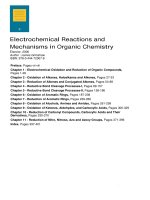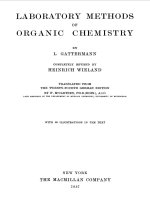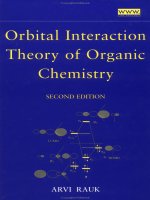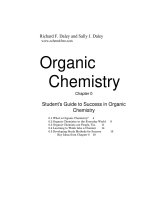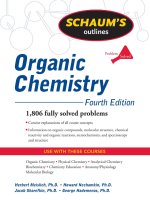lassar cohn application of some general reactions to investigation of organic chemistry
Bạn đang xem bản rút gọn của tài liệu. Xem và tải ngay bản đầy đủ của tài liệu tại đây (12.62 MB, 140 trang )
LIBRARY
UNIVERSITY OF CALIFORNIA.
Clazs
m
www.pdfgrip.com
:>$
*
'
\
-
11
www.pdfgrip.com
www.pdfgrip.com
www.pdfgrip.com
www.pdfgrip.com
www.pdfgrip.com
WORKS TRANSLATED BY
J.
BISHOP TINGLE,
Ph.D.,
PUBLISHED BY
JOHN WILEY & SONS.
Determination of Radicles in Carbon Compounds.
By Dr. H. Meyer, Imperial and Royal University,
Prague. Authorized Translation by J. Bishop TinSecond American Edition,
Ph.D., F.C.S.
including matter specially prepared by Dr. Meyer
for this edition. i2mo, xii+ 162 pages, cloth, $1.00.
gle,
Spectrum Analysis.
By John Landauer, Member of the Imperial German Academy of Naturalists. Authorized English
Edition by J. Bishop Tingle.
44 figures, cloth, $3.00.
8vo, x
+ 239 pages,
Application of Some General Reactions to Investigations in Organic Chemistry.
By Dr. Lassar-Cohn, Professor of Organic Chemistry at the University of Konigsberg. Authorized
Translation by J. Bishop Tingle, Ph.D. izmo,
vii -f 101 pages, cloth, $1.00.
www.pdfgrip.com
APPLICATION
OF
SOME GENERAL REACTIONS
TO INVESTIGATIONS IN
ORGANIC CHEMISTRY.
BY
DK. LASSAR-COHJST,
Professor of Organic Chemistry at the University of Konigsberg.
AUTHORIZED TRANSLATION
BY
J.
BISHOP TINGLE,
Ph.D. (Munich), F.C.S.,
Johns Hopkins University,
FIRST EDITION.
[D.
OF THE
UNIVERSITY
or
\h-
JOHN WILEY &
LONDON:
SONS.
CHAPMAN & HALL,
1904.
www.pdfgrip.com
LIMITED.
Copyright, 1904,
BY
J.
BISHOP TINGLE.
ROBERT DRUMMOND, PRINTER, NEW YORK.
www.pdfgrip.com
(?
'
C6
.
(
TRANSLATOR'S PREFACE.
PROBABLY every student
some period
of his career,
it
only as he
is
chemistry,
becomes more or
immense mass
the
powered by
encounters, and
of organic
of
detail
at
less over-
which he
able to apprehend
is
and generalizations underthat he can emerge from the labyrinth.
the fundamental principles
lying these facts
The
considered
topics
in
this
latest
little
book of
Professor Lassar-Cohn are of considerable importance,
and have hitherto
ment
to
failed
receive
adequate treat-
hoped that the volume
may
who
are
with
the difficulty mentioned above,
and
in other works.
prove
appeal
useful
to
to
It is
students
threatened
also that
and others engaged
teachers
in
it
may
research
work, both on account of the broad, suggestive discussion of the subjects
it
which
includes mention of
it
embraces, and also because
numerous themes which demand
investigation.
J.
BISHOP TINGLE.
CHEMICAL LABORATORY,
JOHNS HOPKINS UNIVERSITY,
October 1904.
iii
www.pdfgrip.com
www.pdfgrip.com
AUTHOE'S PEEFACE.
A
SURVEY
of the
enormous number
which are constantly appearing
in the
of investigations
domain
of organic
chemistry reveals the fact that, although their theoretical
portions are based, in the most severely logical
fashion,
on the tetravalency
technique
An
the
of
research
connection
intimate
extending over
many
of the
is
with
carbon atom, the
essentially
organic
empirical.
investigation,
years, has convinced
me
of the
availability of certain general principles in the practical
part of the work; they are
practical in their nature,
praxis of organic research
partly theoretical,
and
is
partly
their application
to
the
capable of affording general
help and improvement in an enormously large number
In this book I have presented all the material
of cases.
bearing on the subject which I have accumulated.
LASSAR-COHN.
KoNIGSBERG
I.
PH.,
July 1904.
www.pdfgrip.com
www.pdfgrip.com
CONTENTS.
CHAPTER
I.
PAGE
INTRODUCTORY.
FIXATION OF LABILE HYDROGEN ATOMS..
CHAPTER
1
II.
MODIFICATION OF REACTIONS
CHAPTER
IMPROVEMENT
IN
23
III.
THE CONDITIONS OF REACTION.
OVERSTRAIN
48
OF REACTIONS
CHAPTER
IV.
INFLUENCE OF NEIGHBORING ATOMS AND ATOMIC COMPLEXES.
vii
www.pdfgrip.com
.
76
www.pdfgrip.com
APPLICATION OF SOME GENERAL
EEACTIONS TO INVESTIGATIONS
IN ORGANIC CHEMISTRY.
CHAPTER
I.
INTRODUCTORY. FIXATION OF LABILE HYDROGEN
ATOMS.
ALL
investigations in the
domain
of organic chemistry
and most complete manner,
general theory which apply to the
are based, in the firmest
on those parts of
carbon atom, but only a comparatively small number
of
of
them
retain these higher
and more exhaustive points
view in the experimental
portions
Should the desired result not be
tried,
or
less
by one
suitable,
the selection being usually haphazard.
time has arrived
for the
the work.
obtained
method, another, apparently more
is
of
when
it
is
possible
to
The
formulate,
conduct of some operations, a number of general
\
rules derived
from the enormous mass
www.pdfgrip.com
of experimental
2
APPLICATION OF SOME GENERAL REACTIONS.
material which has accumulated, and, as a corollary,
many methods which are
chemical investigations. It may
to develop considerably
in
use for organic
be
hoped
process
is
and
that, in course of time, the blind, trial
may
offered as
be increasingly restricted; this
book
an attempt to systematize methods
work, and treats of the following topics:
labile
failure
little
hydrogen atoms;
of
fixation o)
im^
modification of reactions;
provement in the conditions of reaction by due recognition
of the circumstances in
which the product
fluence of neighboring atoms
formed; in-
is
and atomic complexes;
some remarks on the "overstrain"
also
of reactions.
FIXATION OF LABILE HYDROGEN ATOMS.
Before the actual investigation can be
it
is
commenced
frequently of the greatest importance to
protect, highly reactive (labile)
fix,
or
hydrogen atoms which
are present in the material to be used or in the reagents.
Methods
suitable for this purpose are
employed,
but
they
obviously
where the investigation
is
not
are
now
only
frequently
applicable
concerned with the
behavior of the labile hydrogen atom in the mother-
The object of fixation is to prevent the
hydrogen atom participating in reactions, and so either
substance.
complicating
the
the change which
phenomena
it is
or
entirely
inhibiting
desired to investigate.
Fixation
www.pdfgrip.com
FIXATION OF LABILE HYDROGEN ATOMS.
is
3
by substituting for the hydrogen
atom or group which must be of such
accomplished
some
suitable
a nature that
atom
it
will easily take the place of the
and be
the mother-substance,
in
hydrogen
itself
readily
displaced from the product of the main reaction by
hydrogen, which must enter the molecule in its original
Although the term "fixation"
position.
to designate this procedure,
that
will
fixation
amines, but
it
is
employed
only universally employed for
is
amino hydrogen
is
be readily understood
and reverse substitution.
consists of substitution
it
At present
the
it
in
the
nitration
just as important
of
aromatic
and suitable
for
the protection of the hydrogen of hydroxyl and imino
if
groups
these are present in the
investigation.
Even
in the case of
tives nothing of general application
although,
as will be apparent
is
compounds under
the amino derivaat present
from what
known,
follows,
a
very large number of isolated facts have been recorded.
A
amount
considerable
of
work
in various directions
has been done on the preparation of mononitranilines,
and a
brief consideration of
present
state
of
it
will best illustrate the
knowledge of the subject of
this
chapter.
Failure must, of necessity, attend any attempt to
by means of nitric acid, compounds
containing the amino group, because the acid oxidizes
this group more rapidly than it attacks the nucleus.
nitrate directly,
www.pdfgrip.com
4
APPLICATION OF SOME GENERAL REACTIONS.
In these circumstances, at an early stage of the investigation of aniline, attention was directed to the pro-
methods
vision of
of protecting the
the nitration process, or of fixing
hydrogen atoms.
may
amino group during
one or both of the
In the case of aniline protection
be obtained by dissolving
it,
before nitration,
in a large proportion of concentrated sulphuric acid;
of acid restricts the action of the nitric
this excess
amino
acid to the nitration of the nucleus, and, as the
group
is
protected, the complete decomposition of the
molecule
is
reaction
is
chief
metanitraniline, but
and paranitraniline
aniline
The
prevented.
nitrate
product
a mixture of
obtained by the
is
of
the
ortho
addition
of
to concentrated sulphuric acid.
These two methods
of course, only applicable
are,
to such amines as are stable towards sulphuric acid;
those about to be described, although hitherto only
employed
in
the
case
tolerably general utility.
anilines
of
A
aniline,
appear to be of
consideration of acylated
shows that the nitration of acetanilide yields
a mixture of the three nitranilines, the para derivative
predominating.
Benzanilide
behaves
in
a
similar
manner, except that the proportion of meta compound
These acylanilides were the first to be
is
small.
employed on a large
scale for the preparation of pure
orthonitraniline, but their use proved to be so trouble-
some that
since 1885
it
has been superseded by the
www.pdfgrip.com
FIXATION OF LABILE HYDROGEN ATOMS.
indirect
following
method.
Acetanilide
is
5
converted
into paracetanilide sulphonic acid,
NH-C H
2
3
\
\/
S0
which
is
3
H
nitrated in sulphuric acid solution;
the nitro
group enters in the ortho position relative to the acet-
amino group because the para position is occupied.
The acid solution is diluted and boiled, the dilute sulphuric acid hydrolyzes the acetamino group, and the
resulting,
readily
by means
precipitated
conversion
nitranfline
soluble,
of
is
the
of
acid
nitrosulphanilic
hydrogen
The
chloride.
acid
nitrosulphanilic
into
is
ortho-
by heating the former with
effected
hydrochloric acid, under pressure,
at
170-180.
Apart from the indirectness of the method, it suffers
from the further disadvantages that chemically pure
must be employed, and that, during the
sulphonation, the temperature must not be allowed
acetanilide
to- rise
is
unduly; inconsequence of these drawbacks
unsuitable for general use
1889
large
orthonitraniline
by the
inexpert.
it
Since
has been easily obtainable, in
quantity, by means
of a
patented process which
requires no special precautions,
the use of sealed tubes.
and does not involve
Oxanilide, which
www.pdfgrip.com
is
the start-
APPLICATION OF SOME GENERAL REACTIONS.
6
ing-point in the process,
concentrated
group
sulphonic
product
with
sulphuric
acid;
is
by means
sulphonated
occupies
of the reaction
nitric acid,
is
in
the
case
this
para
cooled to
also
position.
of
the
The
40-50, and treated
which yields dimtroxanilidodisulphonic
acid,
NH-CO-CO.NH
\/
\/
S0 3H
S0
3
H
The
elimination of the oxalyl and sulphonic radicles
from
this
compound
is
readily accomplished
water and boiling at 120-150
At
first
there
is
by adding
in a reflux apparatus.
a considerable gas evolution, due to
the decomposition of the oxalyl group ; later the boiling
proceeds quietly, and after several hours the sulphonic
radicle
is
is
The
eliminated.
of
yield
orthonitraniline
75 per cent, of the crude oxanilide employed.
readiness with which the oxalic acid radicle
is
The
eliminated
and decomposed by means of dilute sulphuric acid
would indicate for it a more extended use than it has
hitherto
in
the
received.
In
preparation of
successfully
adapted
to
addition
to
its
orthonitraniline
the
employment
it
preparation
has been
of
dinitro-
diaminoanthraquinone from diaminoanthraquinone ;
is
this
converted into the oxalyl derivative, and the latter
www.pdfgrip.com
FIXATION OF LABILE HYDROGEN ATOMS.
nitrated in concentrated sulphuric acid solution.
most
reactions take place
was granted
7
The
In 1903 a patent
readily.
a process which not only allows of
for
the convenient preparation of paranitraniline, but also
permits of the regeneration of original acylated sub-
The
stance.
reactions
m
CJS/
XX
is-
nitrated
and
follows:
>N-C 6H 5
,
aniline
under pressure,
thus
acid
the
liberates
and regenerates phthalanil.
Derivatives of aniline and nitro acids
for
phthalanil,
yields chiefly paranitrophthanil, which,
when heated with
paranitraniline
as
are
production
of
higher
paranitrobenzanilide,
in
may
nitrated
derivatives;
concentrated sulphuric
on treatment with
solution, yields,
be used
nitric acid,
paratrinitrobenzanilide,
NH-CO-C
N0
N0
and,
by
hydrolysis,
preparing dinitraniline
erto
it
6
H N0
4
2
2
2
dinitr aniline.
is
This
method
of
mentioned here, because hith-
has not been adapted for the preparation of
a mononitraniline.
www.pdfgrip.com
8
APPLICATION OF SOME GENERAL REACTIONS.
Acyl derivatives of aniline are by no means the only
ones which have been employed for the production
of nitro derivatives; the readiness with which the
amino group combines with aldehydes has
led to the
use of these compounds also for nitration purposes.
A
typical derivative of this class
is
C 6H5 .CH:N-C 6H5
from benzaldehyde and
unstable substance, and
constituents
by the
temperature.
On
and therefore
of
aniline;
is
benzylidenaniline,
,
it
is
a somewhat
readily resolved into
its
action of dilute acids at the ordinary
account of the absence of water,
hydrogen and other
ions,
hydrolysis
of the benzylidene derivative does not occur in con-
centrated sulphuric acid solution, and
experiment that such a solution
it
is
found by
readily nitrated
is
without the production of resinous bodies; subsequent
dilution of the
acid liquid causes separation of the
By means
free nitro product.
yields
90
of this
acetic
benzylidenaniline
in
acetic anhydride,
and subsequent
glacial
method
aniline
Solution of the
per cent, of paranitraniline..
acid,
addition
of
nitration yields, in
addition to paranitraniline, 15 per cent, of the ortho
derivative
together
experimental
with
conditions
products.
The
obviously
more
resinous
here
are
complicated than in the previous case.
Purpurin (trihydroxyanthraquinone) has also been
www.pdfgrip.com
FIXATION OF LABILE HYDROGEN ATOMS.
employed for the purpose of combining with
which is subsequently nitrated; the purpurin
NH.C H
14
concentrated
in
with
by
aniline,
anilide,
4
7
sulphuric acid
nitric acid, and,
9
solution,
is
treated
boiling the resulting product
with sulphuric acid (70 per cent.), purpurin and orthonitraniline are obtained.
This appears to exhaust the
list
of readily
decom-
posable aniline derivatives which have been employed
the production of mononitranilines;
for
reference will be
made
to
subsequent
the production of ortho,
meta, and paranitranilines by the partial reduction of
a mixture of ortho and metadinitrobenzene, or by
its
treatment with ammonia, and also by the action of
alcoholic
ammonia on ortho and parachloronitrobenzene
(vide p. 84).
These methods have
all
been tested in
the laboratory, but, strictly speaking, they have nothing
to do with the nitration of aniline.
The same
is
true
more recently described process for the production
ortho and paranitraniline, from the corresponding
of a
of
chloronitrobenzenes,
monia
A
at
170.
The
by
interaction with aqueous
yield
is
am-
practically quantitative.
consideration of the previous pages demonstrates
that even in the case of aniline, which has been the
www.pdfgrip.com

